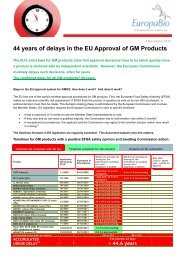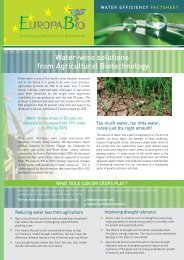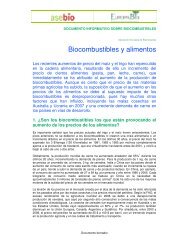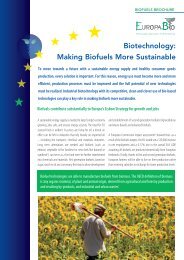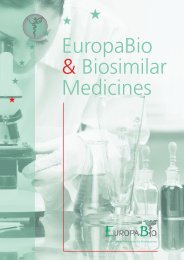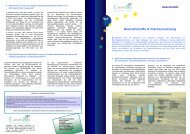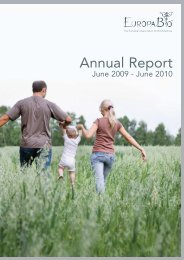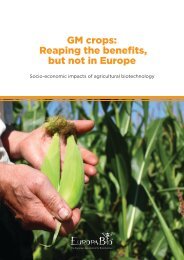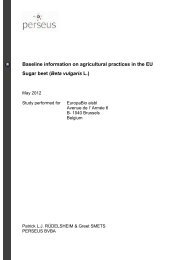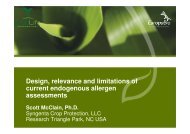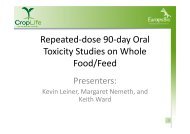Baseline information on agricultural practices in the EU ... - Europabio
Baseline information on agricultural practices in the EU ... - Europabio
Baseline information on agricultural practices in the EU ... - Europabio
Create successful ePaper yourself
Turn your PDF publications into a flip-book with our unique Google optimized e-Paper software.
- In Germany, <strong>the</strong> Plant Protecti<strong>on</strong> Product Reducti<strong>on</strong> Programme was devised and published <strong>in</strong><br />
2004. This Nati<strong>on</strong>al Acti<strong>on</strong> Plan <strong>on</strong> Susta<strong>in</strong>able Use of Plant Protecti<strong>on</strong> Products builds <strong>on</strong> that<br />
programme (2008). The leitmotiv is <strong>the</strong> use of <strong>the</strong> necessary m<strong>in</strong>imum of plant protecti<strong>on</strong><br />
products when all o<strong>the</strong>r practicable opti<strong>on</strong>s to prevent and deter harmful organisms have been<br />
exhausted.<br />
- In 2008, France set a 50% reducti<strong>on</strong>, where possible, by 2018 <strong>in</strong> <strong>the</strong> ‘Ecophyto 2018’. It also<br />
banned <strong>the</strong> 53 most problematic substances, 30 of which would have been banned by <strong>the</strong> end of<br />
2008.<br />
Any change <strong>in</strong> <strong>agricultural</strong> practice will need to be evaluated aga<strong>in</strong>st <strong>the</strong>se objectives. New<br />
developments may offer alternatives to exist<strong>in</strong>g products and present opti<strong>on</strong>s for lower levels of<br />
applicati<strong>on</strong> of active <strong>in</strong>gredients with an improved envir<strong>on</strong>mental profile. Additi<strong>on</strong>ally, <strong>in</strong>tegrati<strong>on</strong> of<br />
genetic tolerances or resistances to pests or diseases may expand IPM strategies.<br />
Pest populati<strong>on</strong>s have <strong>the</strong> potential to develop resistance to <strong>the</strong> crop protecti<strong>on</strong> products used aga<strong>in</strong>st<br />
<strong>the</strong>m, particularly if <strong>the</strong>y are regularly treated with a s<strong>in</strong>gle product. The result is that <strong>on</strong>ce effective<br />
products are no l<strong>on</strong>ger able to c<strong>on</strong>trol <strong>the</strong> pest and have to be replaced. Resistance is a natural<br />
phenomen<strong>on</strong> but its development is an important threat for susta<strong>in</strong>able crop protecti<strong>on</strong> that must be<br />
tackled proactively, through resistance management programmes.<br />
Resistance management is undertaken with<strong>in</strong> <strong>the</strong> c<strong>on</strong>text of an Integrated Pest Management<br />
Strategy. It is possible that resistance management programmes require a change <strong>in</strong> <strong>agricultural</strong><br />
practice, e.g. by implement<strong>in</strong>g diversificati<strong>on</strong> of protective measures <strong>in</strong> adjacent field z<strong>on</strong>es.<br />
The 2000/60/EC Water Framework Directive 24 states that aquatic envir<strong>on</strong>ments throughout <strong>the</strong> <strong>EU</strong> will<br />
have to achieve good ecological status by 2015. Pesticides are <strong>on</strong>e of <strong>the</strong> ma<strong>in</strong> sources of water<br />
polluti<strong>on</strong> and aquatic envir<strong>on</strong>ment degradati<strong>on</strong>. The Groundwater Directive 2006/118/EC 25 has been<br />
developed to elaborate fur<strong>the</strong>r <strong>on</strong> <strong>the</strong> requirements of <strong>the</strong> Water Framework Directive. Member States<br />
have developed nati<strong>on</strong>al laws and regulati<strong>on</strong>s, prohibit<strong>in</strong>g <strong>the</strong> use of some products, limit<strong>in</strong>g <strong>the</strong><br />
applicati<strong>on</strong> of o<strong>the</strong>rs. E.g. <strong>in</strong> Belgium, buffer z<strong>on</strong>es between <strong>the</strong> last treated row and water bodies are<br />
required for certa<strong>in</strong> weed c<strong>on</strong>trol products. Denmark established a mandatory 10 m n<strong>on</strong>-sprayed, n<strong>on</strong>fertilised<br />
and unfarmed buffer z<strong>on</strong>es <strong>on</strong> all water courses (by 2012) and a mandatory 25 m spray<strong>in</strong>gfree<br />
buffer z<strong>on</strong>es around public dr<strong>in</strong>k<strong>in</strong>g water sources (PAN Europe 26 ). Buffer z<strong>on</strong>es are also<br />
recommended near streams or dams <strong>in</strong> Portugal (Anpromis). It is expected that for new crop<br />
protecti<strong>on</strong> products a similar c<strong>on</strong>siderati<strong>on</strong> will determ<strong>in</strong>e if a specific buffer z<strong>on</strong>e is required.<br />
5.3 Irrigati<strong>on</strong><br />
In <strong>EU</strong>-27 <strong>the</strong> total <strong>agricultural</strong> area equipped for irrigati<strong>on</strong> <strong>in</strong> <strong>the</strong> year 2003 accounts for 16 milli<strong>on</strong> ha<br />
<strong>on</strong> a total of 182 milli<strong>on</strong> ha of <strong>agricultural</strong> land (Eurostat, Farm structure survey data 2000, 2003 27 ).<br />
The majority of irrigated areas are c<strong>on</strong>centrated <strong>in</strong> <strong>the</strong> Mediterranean regi<strong>on</strong>. France, Greece, Italy,<br />
Portugal and Spa<strong>in</strong> account for 12 milli<strong>on</strong> ha corresp<strong>on</strong>d<strong>in</strong>g to 75% of <strong>the</strong> total area equipped for<br />
irrigati<strong>on</strong> <strong>in</strong> <strong>EU</strong>-27 (JRC, 2008, Water Requirements for Irrigati<strong>on</strong> <strong>in</strong> <strong>the</strong> European Uni<strong>on</strong>). Whereas <strong>in</strong><br />
<strong>the</strong> Central and Nor<strong>the</strong>rn European countries agriculture is generally ra<strong>in</strong>-fed and irrigati<strong>on</strong> is <strong>on</strong>ly<br />
temporarily used to overcome water shortages dur<strong>in</strong>g summer optimiz<strong>in</strong>g crop yields, <strong>in</strong> Sou<strong>the</strong>rn<br />
Europe it is an essential element of <strong>agricultural</strong> producti<strong>on</strong> (Figure 5).<br />
24<br />
Directive 2000/60/EC of <strong>the</strong> European Parliament and of <strong>the</strong> Council establish<strong>in</strong>g a framework for<br />
<strong>the</strong> Community acti<strong>on</strong> <strong>in</strong> <strong>the</strong> field of water policy, OJ L 327, 22.12.2000, p. 1-72.<br />
25<br />
Directive 2006/118/EC of 12 December 2006 <strong>on</strong> <strong>the</strong> protecti<strong>on</strong> of groundwater aga<strong>in</strong>st polluti<strong>on</strong> and<br />
deteriorati<strong>on</strong>, OJ L372, 27.12.2006, p. 19-31.<br />
26<br />
http://www.pan-europe.<strong>in</strong>fo/Resources/Reports/NAP_best_practice.pdf<br />
27<br />
http://appsso.eurostat.ec.europa.eu/nui/show.do?dataset=ef_lu_ofirrig&lang=en<br />
Page 42 of 64



